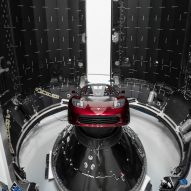A SpaceX rocket launched an unprecedented number of satellites into space on Sunday, setting a new record for the most spacecraft ever deployed in a single mission.
Called Transporter-1, the mission transported 143 spacecraft into Earth orbit, including compact nano- and microsatellites from different countries and corporations.
This beats the previous record of 104 satellites launched during a mission by the Indian Space Research Organization (ISRO) in 2017.
SpaceX’s rocket was launched at 10 a.m. in the morning from the Cape Canaveral Space Force Station in Florida, which was the first dedicated mission of the company’s SmallSat Rideshare program.
As the name suggests, the initiative looks like a kind of UberPool for satellites, enabling different operators to pack up space and share the costs on the same rocket, rather than investing more than $ 60 million to individual rocket for rent.
Under the SmallSat Rideshare program, it costs only $ 1 million to send a 200-kilogram spacecraft into a solar-synchronous orbit (SSO), which houses image, military and weather satellites.
SpaceX aims to serve this orbit every four months via a regular service, in an effort to “provide increased access to space for small satellite operators looking for a reliable, affordable ride around the orbit”.
Rocket designed for reuse
The relative affordability of the program is also related to the design of SpaceX’s Falcon 9 rocket, which was used for the mission and developed to be partially reused.
The most expensive part of the rocket – the first phase booster that drives it off the ground and falls away as soon as it reaches its goal – can land on one of the company’s ocean-bound droneships and can then be used for other missions to reduce the astronomical cost of rockets to drop.
Falcon 9 launches 143 orbiting spacecraft – the most ever deployed on a single mission – to complete SpaceX’s first dedicated SmallSat Rideshare application mission pic.twitter.com/CJSUvKWeb4
– SpaceX (@SpaceX) 25 January 2021
The first phase booster used in the Transporter-1 mission, for example, was previously used in four other missions, including for SpaceX’s Starlink program, which sees a constellation of thousands of satellites set up in Earth’s orbit to provide high speed internet access around the world.
Number of satellites that will increase fivefold in the next decade
On board the Transporter 1 mission were spacecraft from research organizations such as NASA and the University of South Florida Institute of Applied Engineering, along with eight communications satellites by the Canadian company Kepler and 48 shoe bag-sized Earth image satellites by Planet Labs in San Francisco. .
As part of the mission, ten of SpaceX’s own Starlink satellites were also launched – the first in the constellation to be deployed in a polar orbit, where they will traverse the earth from north to south.
This comes shortly after a new Starlink mission launched 60 satellites into orbit on January 20, as part of the company’s goal of establishing a mega – constellation of at least 12,000 satellites by the middle of the decade.
With the advent of smaller, more affordable satellites and ride-sharing programs such as those of SpaceX or the Vega program by European company Arianespace, the number of satellites in Earth’s orbit will double in the next decade.
This has raised concerns about light pollution among astronomers, as well as increasing the risk of collisions and ultimately adding the estimated 6,000 tons of space debris already floating in a low orbit around the earth – including 2,500 of our planet’s 5,850 satellites.
In an effort to tackle this space decline, Kyoto University recently announced that it is developing the world’s first wooden satellite in collaboration with Sumitomo Forestry, which will burn up completely by the end of its life.
